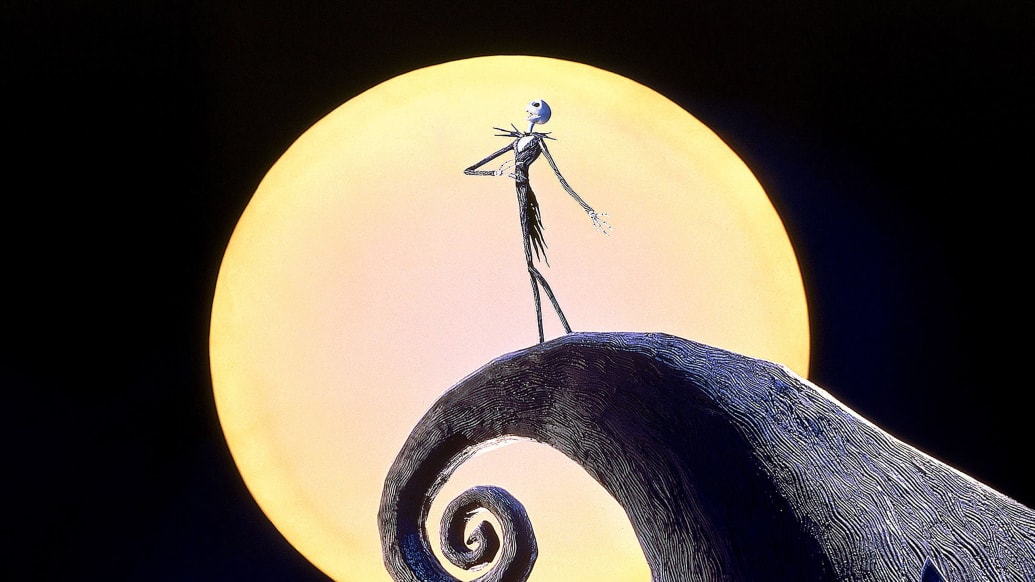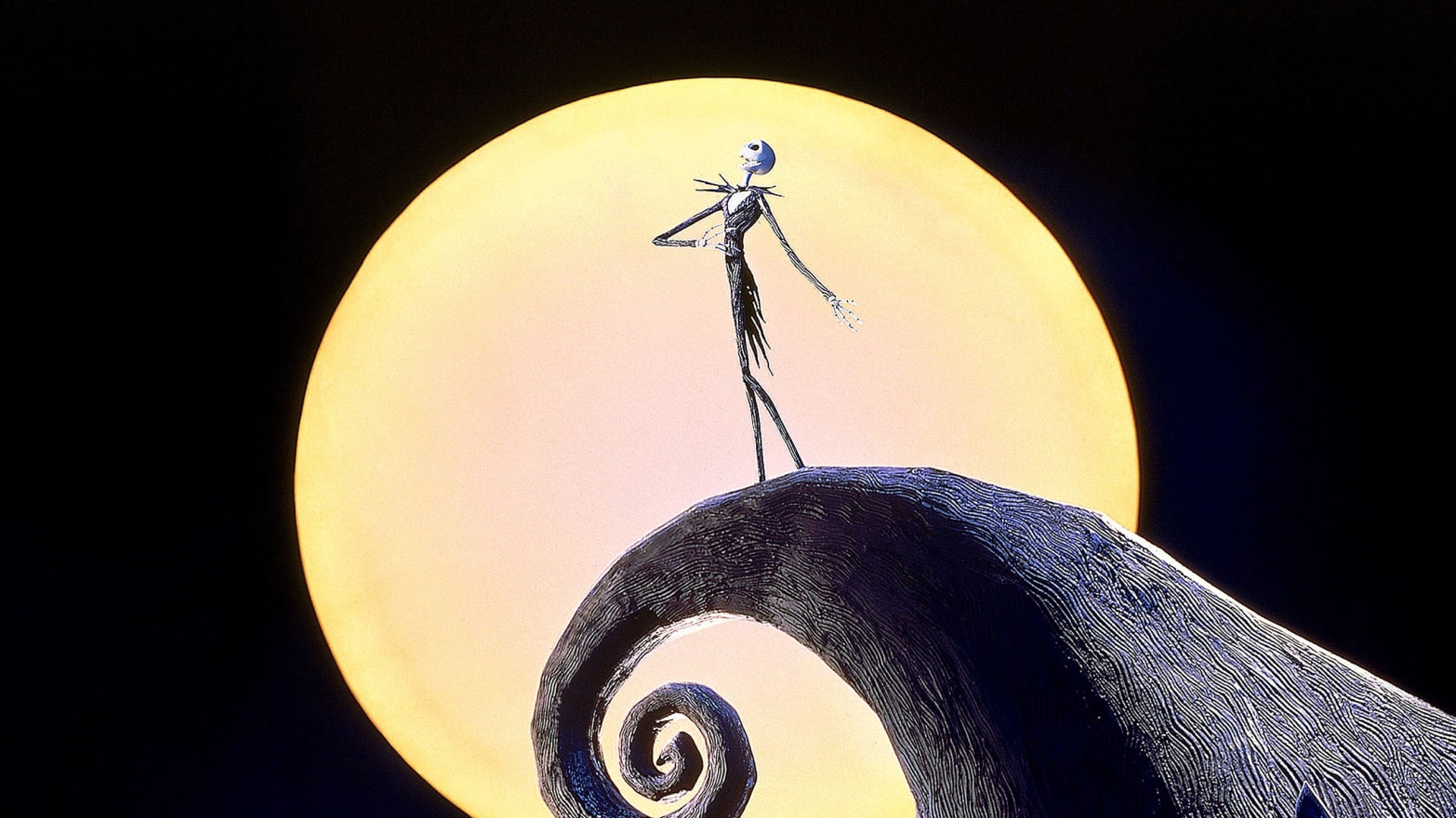What’s this? Twenty years ago, an $18 million stop-motion-animated musical featuring a singing and dancing skeleton was quietly released in theaters. But the film took on a life of its own after it left cinemas and, millions of Sally dolls and Hot Topic t-shirts later, The Nightmare Before Christmas is now considered a Halloween classic.

Directed by Henry Selick and produced/co-written by Tim Burton, The Nightmare Before Christmas centers on Jack Skellington (voiced by Chris Sarandon), the de facto ruler of ghoulish Halloween Town. But he’s become tired of celebrating Halloween each and every year. One day, he opens a portal to Christmas Town, and decides to switch things up a bit—kidnapping Santa Claus, and recreating the yuletide cheer in Halloween Town. Meanwhile, Jack has fallen for a rag doll named Sally (voiced by Catherine O’Hara), and wishes to free her from the clutches of her creator, the resident mad scientist Doctor Finkelstein.
Featuring eye-catching gothic design and beautiful musical numbers by Danny Elfman, the film grossed a meager $50 million when it was first released in theaters, but has made countless millions in merchandise sales since.
The Daily Beast spoke with the film’s director, Henry Selick (Coraline), about the tales behind the making of The Nightmare Before Christmas.
Where did the idea for The Nightmare Before Christmas come from?
I knew Tim [Burton] from CalArts and Disney in the early ‘80s, and he’d come up with the idea for Nightmare as a TV special along the lines of those Rankin/Bass low-budget stop-motion staples like Rudolph the Red-Nosed Reindeer. Tim rewrote the classic poem, “’Twas the Night Before Christmas,” along with designs for Jack Skellington, his dog, Zero, and Santa Claus. His creative partner, Rick Heinrichs, is the guy who sculpted everything, and he’d done sculpts of those characters. They pitched it to Disney in 1983, but it just wasn’t meant to be. At that time, it had no relationship to what Disney’s identity was, so they didn’t develop it. It was when Disney was kind of on the wane, and hadn’t been reinvigorated by their spate of musicals. It was one of those moments of, “I can’t believe they don’t get it!” but that’s what happens.
So when did Nightmare start gaining traction?
After Tim had done Beetlejuice and the first Batman movie, he was a real superstar, and Tim, with his new powers, wanted to take Nightmare away from Disney and investigate making it himself. But Disney said, “No, we own that… come back to Disney and we’ll let you make it.” Nightmare was sort of a gift to Tim, and Tim’s never really enjoyed directing stop-motion; it makes him nervous to be on the set so much. So, Tim came to me and asked if I’d direct it. We started production in 1990. The first writer was Michael McDowell, who wrote Beetlejuice, but he was too ill and just couldn’t do it. We had three songs by Danny Elfman but no real screenplay, and we had to start because we had a pretty tight budget [$18 million], and had to finish the movie in time. So, we started off with the song “What’s This?”
You only had three songs and a bit of screenplay when you started?
We didn’t really know any better. We were just happy to be doing a feature in stop-motion. Then, Danny’s girlfriend at the time, Caroline Thompson, came onboard to help with the screenplay and did a fabulous job of stitching the songs together and making it work.
There are some pretty amazing stats about Nightmare: it took a crew of 120 people three years, shooting on 20 different sound stages, to put the stop-motion together.
It’s funny. What you said is true, and I was on the film for three-and-a-half years. The stop-motion animation took about 18 months, but with pre-production, where you storyboarded every single shot, it did add up. At its peak, it was about 120 people working on it, and we had between 12-17 animators on the job. It’s an insane way to make a movie, but a lot of fun. It’s joy, along with a lot of pain.
How difficult was it to design these characters, and get the movements down? I read that your team used about 400 heads for Jack Skellington.
I did a lot of stop-motion station ID stuff for MTV, and that led to getting some commercials—including, like, nine Pillsbury Doughboy commercials. The Pillsbury Doughboy only had seven expressions, but with Jack, we had to add many more heads and expressions, since we needed him to emote. Luckily, he has a Ping-Pong ball for a head and two holes for eyes, so you’d just have to focus on mouth expressions and brows. But yeah, we had a lot of heads for Jack.
What was the toughest character for your team to design on Nightmare?
There’s three steps: drawing, sculpting, then actually building the thing. Oogie Boogie was the toughest because he’s big and pretty shapeless. Ultimately, Rick Heinrichs had to re-sculpt it, and then, when he gets his skin pulled off and he’s filled with bugs, that took some years off a few animators’ lives—it’s three or four killer shots and took about four months.
There were some complaints at the time that Oogie Boogie was a bit racist.
Ken Page, the Broadway star who happens to be black, was hired to do the voice, and after seeing some of the old Betty Boop cartoons where they’d use Cab Calloway to voice it, I just thought it was more of a New Orleans thing. It didn’t occur to me that it was racist. People are desperate to look for things to attack. Someone said that naming the mad scientist Dr. Finkelstein was anti-Semitic. Why? What are you talking about?
I read that Vincent Price was originally cast as Santa Claus, and even filmed scenes.
We recorded him and he would’ve done the introduction to the film, since it’s supposed to be Santa Claus’s voice at the beginning/end, but [Price] had just lost his wife, and he was despondent, and it just didn’t work. He was the first choice, that didn’t work out, and we met with Don Ameche, who was insanely grouchy. I couldn’t believe how grouchy he was. Then we met with James Earl Jones, and Danny had a weird moment where he went up to him and said he’d written the part especially for James Earl Jones, and James Earl Jones got very angry and yelled, “You don’t know me!” It was a very tough voice to cast, and we just went with a local actor from San Francisco [Ed Ivory].
Were there any other voice casting issues?
When Danny tried to do the speaking voice of Jack as well as the singing voice, it just wasn’t up to the level of his singing, so we got Chris Sarandon to do Jack’s speaking voice. Tim and Danny have mended fences over the years, but it really upset Danny when I had to replace his speaking voice, and I had to go to Tim to do it. Then, later in the film, it was supposed to go to Santa Claus finishing the poem at the film’s end, but that didn’t work either, so we scrapped it. Danny and Tim’s friendship is very weird.
Now, was Tim too tied up with Batman Returns to have much of a hand in this once the production process began?
I was totally in charge of directing, but we’d send everything to Tim and he would check it out, and he came to visit the set a few times. He was too busy with Batman Returns, and then he did Ed Wood. He could do two live-action features in the time took us to do a stop-motion film. It was a great relationship because he utterly showed faith in what we were doing, and trusted us. And then Tim, besides supporting us, protected us, so we didn’t have to listen to any notes from the studio.
What sort of notes was Disney giving you?
We got a very specific note from Jeffrey Katzenberg, who was still at Disney at the time, that the clown’s face was too rough for tone. We initially had it as a tear-away face, and when he’d tear his face away it was bloody and awful, and I agreed with that one, so we just had it be hollow.
Did it bug you that the movie was presented as, Tim Burton’s The Nightmare Before Christmas, when you directed it?
That bothered me for a while. It was Tim’s idea and he’s the powerful producer, but during the making of the film, it wasn’t called that—until about a month before it was released. And we had already shot this title sequence with candy corn letters. I was shoved pretty far in the background, which threw me, but it was probably a good marketing decision. Plus, there was A Nightmare On Elm Street, so I think they wanted to differentiate from that—and also get Tim’s audience in the theater.
Did you and Tim have any disagreements?
I’d come up with an alternate ending that he didn’t like. It was that Oogie Boogie was actually Dr. Finkelstein in disguise—sort of a Scooby-Doo sort of ending. I storyboarded it but we didn’t end up shooting it. Also, I wanted the world to be made right at the end, and for us to include those shots of Santa Claus taking away the shrunken head from the kid and giving him the puppy, etc. Tim hated those shots, but he showed the movie to some friends and they wanted to keep it.
What’s the weirdest piece of Nightmare paraphernalia you’ve seen?
In Japan, there was a Halloween show with actors dressed up with the characters but they added this heavy sexual content, as well as vampires. It pushed it into a whole other zone that wasn’t in the movie. And there’ve been a lot of people with tattoos. At a screening in L.A., a woman had saved spots for Tim, Danny, and me to autograph her leg, and then she went and got that tattooed. As far as the mainstream merchandise, it took Disney a long while to understand the gold mine they had, and it even took them a long time to call it a Disney movie instead of a Touchstone movie. And then Hot Topic came along with their Nightmare apparel. Maybe it helped create the Goth movement.

